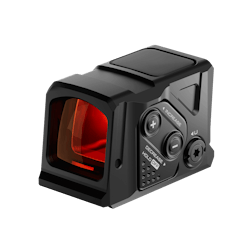Glock + Aimpoint Collaboration Puts Weapon/Sight Combo in Slim Package
More on OFFICER.com
Download the March/April issue of OFFICER Magazine.
Click Here to subscribe to OFFICER Magazine.
One of the big announcements at SHOT Show this year was a collaboration between GLOCK and Aimpoint. The all-new GLOCK x Aimpoint COA Combo pairs Aimpoint’s newest super slim red dot optic to GLOCK’s equally slim GLOCK Model 48 9mm (among other models). The pairing of the optic and slide takes place in an all new (and proprietary) optic mounting system called A-CUT. This system mounts the COA optic directly to the GLOCK’s slide without use of a mounting plate and replacing the rear sight as part of the system.
One of the challenges of mounting most red dot sights (RDS) is that first you mount a plate onto the slide using two screws, and then you mount the optic to the plate using two more screws. If any of those four screws come loose under the pressures created by recoil while firing the weapon, or even while chambering a round or clearing the weapon, then the RDS can be off target. “Holding zero” is one of the biggest challenges for any optic and part of what it depends on is a secure mount. If there’s a way to create a more secure mount—which would mean doing away with multiple screws that can come loose—then it’s a good idea.
If you’ve ever been snow skiing, you can more easily relate to the strength and benefits of the A-CUT mounting system. There is no mounting plate used. The front lower edge of the COA RDS slides into a cut in the GLOCK slide itself. Along the center line of the optic cut, in line with the slide, front to rear, is a raised surface that fits into a mated cut space along the bottom of the COA optic. Once toed in under the front cut and settled onto the bottom surface, the optic is held so that it can’t move forward or to either side. The rear of the optic settles and is held down by a clamp that incorporates the rear sight. The clamp/rear sight is held in place by two screws.
So you might think, “Wait; I thought you said screws could be bad?” While they can be, they are also, to some extent, inevitable when mounting accessories. The difference in this case is that instead of two to four screws that hold the optic to the slide, all of which would be experiencing sheering forces with every cycle of the slide, this is two that hold on the rear sight and the clamp end pushes down on the back of the optic. The two screws used experience, as the slide cycles, only the sheering forces created by the weight of the rear sight which is significantly less than that of the COA optic. Through the use of this system the optic has far less chance of ever moving and losing zero as a result.
Now let’s take a closer look at the optic itself. One of the biggest challenges faced in putting a RDS on a handgun is getting the optic’s width down close to that of the handgun slide. Referred to online as “Ultra compact,” the COA is only 0.87” wide - the same width as the slide on a GLOCK Model 43, 43X and 48. That makes it thinner, in fact, than the slide of a GLOCK Model 19, one of the models GLOCK and Aimpoint are making the system for. However, that reduced exterior dimension doesn’t result in a reduction of the sighting window. Aimpoint engineered and designed the body of the RDS to be thinner but just as strong, and it’s reasonably safe to assume that part of that size difference is related to the A-CUT mounting system.
At the end of the day though, the questions that have to be asked and answered are these:
- Does such a small optic offer the ability to adjust windage and elevation for the dot? The answer is yes.
- Does such a small optic offer a large enough sighting window and clear view? Again, the answer is yes.
- Does such a small optic offer the ability to adjust the brightness of the dot? Yes, and that’s a big surprise for many. On either side of the optic are matching buttons that allow for adjusting intensity of the dot. •Does the optic have to be removed from the slide to change the battery? No… and that means that the optic doesn’t have to be rezeroed after replacing the battery. The optic itself isn’t moved or loosened in any way. There’s a small screw that holds in the battery tray so battery replacement can be easily accomplished with minimal time lost.
One observation that was made during test firing is that even though the hard sights can be cowitnessed, the mounting design allows for the hard sights to take up less of the visual space in the viewing window. That also means that the weapon doesn’t have to have high or “suppressor height” sights which so many agencies seem to have a challenge with.
At SHOT Show, our editorial representative was able to shoot this weapon/sight combination and was quite pleased with ease of dot acquisition and overall slimness of the package. The observation was also made that the weapon/sight combination “seemed” smaller. That’s not a surprise given how much slimmer the GLOCK 48 is compared to most other GLOCK models and how small the overall optic size is.
About the Author
Lt. Frank Borelli (ret), Editorial Director
Editorial Director
Lt. Frank Borelli is the Editorial Director for the Officer Media Group. Frank brings 20+ years of writing and editing experience in addition to 40 years of law enforcement operations, administration and training experience to the team.
Frank has had numerous books published which are available on Amazon.com, BarnesAndNoble.com, and other major retail outlets.
If you have any comments or questions, you can contact him via email at [email protected].



